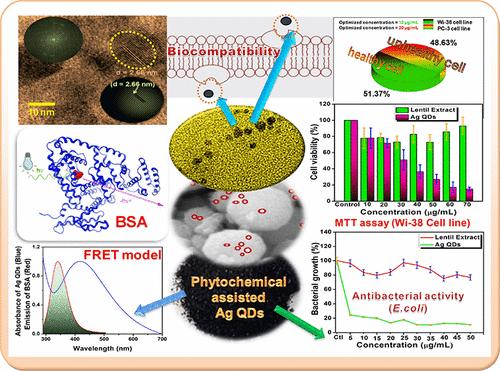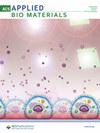Lentil Extract-Mediated Ag QD Synthesis: Predilection for Albumin Protein Interaction, Antibacterial Activity, and Its Cytotoxicity for Wi-38 and PC-3 Cell Lines
IF 4.6
Q2 MATERIALS SCIENCE, BIOMATERIALS
引用次数: 0
Abstract
Recent focus has been directed toward semiconductor nanocrystals owing to their unique physicochemical properties. Nevertheless, the synthesis and characterization of quantum dots (QDs) pose considerable challenges, limiting our understanding of their interactions within a biological environment. This research offers valuable insights into the environmentally friendly production of silver quantum dots (Ag QDs) using lentil extract and clarifies their distinct physicochemical characteristics, previously unexplored to our knowledge. These findings pave the path for potential practical applications. The investigation of the phytochemical-assisted Ag QDs’ affinity for BSA demonstrated modest interactions, as shown by the enthalpy and entropy changes as well as the associated Gibbs free energy during their association. Steady-state and time-resolved fluorescence spectroscopy further demonstrated a transient effect involving dynamic quenching, predominantly driven by Forster resonance energy transfer. Additionally, the study highlights the potential broad-spectrum antibacterial activity of Ag QDs (<5 nm, a zeta potential of −3.04 mV), exhibiting a remarkable MIC value of 1 μg/mL against Gram-negative bacteria (E. coli) and 1.65 μg/mL against Gram-positive bacteria (S. aureus). They can readily enter cells and tissues due to their minuscule size and the right chemical environment. They cause intracellular pathway disruption, which leads to cell death. This outcome emphasizes the distinctive biocompatibility of the green-synthesized Ag QDs, which has been confirmed by their MTT assay-based cytotoxicity against the PC-3 and Wi-38 cell lines.

扁豆提取物介导的 Ag QD 合成:白蛋白相互作用的偏好、抗菌活性及其对 Wi-38 和 PC-3 细胞株的细胞毒性
半导体纳米晶体因其独特的物理化学特性而成为近期研究的重点。然而,量子点(QDs)的合成和表征带来了相当大的挑战,限制了我们对其在生物环境中相互作用的理解。这项研究为利用扁豆萃取物以环境友好的方式生产银量子点(Ag QDs)提供了宝贵的见解,并阐明了其独特的物理化学特性。这些发现为潜在的实际应用铺平了道路。植物化学物质辅助的 Ag QDs 与 BSA 的亲和力研究表明,它们之间的相互作用并不强,这体现在它们结合过程中的焓和熵变化以及相关的吉布斯自由能。稳态和时间分辨荧光光谱进一步证明了涉及动态淬灭的瞬态效应,主要由福斯特共振能量转移驱动。此外,该研究还强调了 Ag QDs(<5 nm,zeta 电位为 -3.04 mV)潜在的广谱抗菌活性,对革兰氏阴性菌(大肠杆菌)的 MIC 值为 1 μg/mL,对革兰氏阳性菌(金黄色葡萄球菌)的 MIC 值为 1.65 μg/mL。由于其微小的体积和适当的化学环境,它们很容易进入细胞和组织。它们会破坏细胞内的通路,导致细胞死亡。这一结果强调了绿色合成的 Ag QDs 独特的生物相容性,其对 PC-3 和 Wi-38 细胞系的 MTT 细胞毒性也证实了这一点。
本文章由计算机程序翻译,如有差异,请以英文原文为准。
求助全文
约1分钟内获得全文
求助全文
文献相关原料
| 公司名称 | 产品信息 | 采购帮参考价格 |
|---|

 求助内容:
求助内容: 应助结果提醒方式:
应助结果提醒方式:


